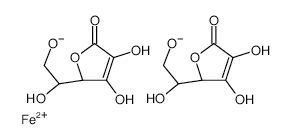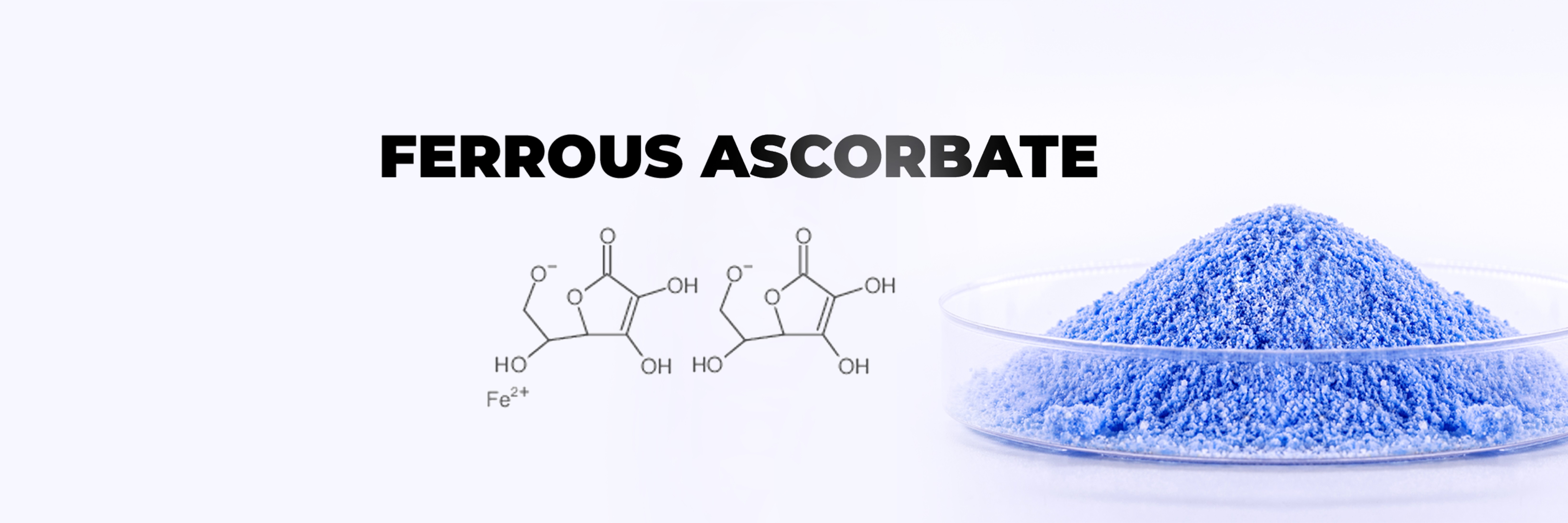INTRODUCTION
Ferrous Ascorbate is a combination of vitamin C and iron. Ferrum or iron helps to replenish the iron stores in the human body. Ascorbate contains vitamin C that improves iron levels in the body by increasing its absorption from different sources.
Manufacture
By reacting alkali or alkaline earth metals with ferrous sulfate, the corresponding ferrous salts are formed, which are then reacted with ascorbic acid in slightly acidic or neutral conditions in an aqueous medium. To obtain ferrous ascorbate, the mother liquor must be filtered.
| Synonyms | Ascorbic acid ferrous salt Vitamin C iron(II) salt L-(+)-Ascorbic acid iron(II) salt |
| CAS no. | 24808-52-4 |
| EINECS no. | 246-469-7 |
| Molecular formula | C12H16FeO12 |
| Molecular weight | 406.08 |
| Structure |  |
APPLICATIONS
Ferrous Ascorbate has several applications in the pharmaceutical industry and is a valuable component in many medications and supplements.
| Iron supplement | It is commonly used as an iron supplement in the pharmaceutical industry to treat iron-deficiency anemia. It is available in various forms such as tablets, capsules, and syrups. |
| Nutraceutical | It is also used as a nutraceutical, which is a dietary supplement that provides health benefits beyond basic nutrition. It is often used in combination with other vitamins and minerals to promote overall health and wellness. |
| Antioxidant | Ascorbate, the other component of Ferrous ascorbate, is a powerful antioxidant. Antioxidants help to neutralize harmful free radicals in the body, which can cause damage to cells and contribute to the development of various diseases. |
| Anti-inflammatory | Ascorbate also has anti-inflammatory properties and can help to reduce inflammation in the body. This makes it useful in the treatment of conditions such as arthritis and other inflammatory disorders. |
| Immune system support | Ascorbate is also essential for the proper functioning of the immune system. It plays a vital role in the production of white blood cells and helps to protect the body against infections and diseases. |
SPECIFICATIONS
| Test | Unit | Specification |
|---|---|---|
| Appearance | – | A dark violet colored powder |
| Solubility | – | Freely soluble in wáter |
| Identification A. Iron test B. Ascorbic test | – – | The solution will give blue colour A grey precipitate is formed |
| Loss on Drying | % | ≤ 10 |
| Heavy metals | ppm | ≤ 25 |
| pH (aq. solution) | % w/v | 1.0 |
| Assay (ODB) 1. Content of Iron 2. Content of Ascorbic acid | % % | 14.0 – 17.0 60.0 – 70.0 |
| Residual solvent | – | No organic solvent |
| Microbiological contamination 1. Total aerobic microbial count 2. Total Yeast & Mold count 3. Specific micro organisms a. Escherichia Coli b. Pseudonimas aeruginosa c. Staphylococcus aureus d. Salmonella. sp. | cfu/g cfu/g absent/g absent/g absent/g absent/10 g | ≤ 10(superscript)3 ≤ 10(superscript)2 Should comply Should comply Should comply Should comply |
PACKING
20 kg HDPE drum.
STORAGE
Store in cool place. Keep container tightly closed in a dry and well-ventilated place.
CERTIFICATION
GMP & DMF
No matter the quantity you need, our exceptional quality and service will make ExSyn your supplier of choice! If you need any additional information or SDS, please contact us.
5-Methyl-3-vinyl-2-oxazolidinone (V-MOX) is a highly reactive monomer valued for its low viscosity, mild odor, and excellent reactivity. It is widely used as a reactive diluent in UV-curable inks and coatings, where it enhances adhesion, produces brighter colors, and improves safety compared to conventional diluents. In addition, V-MOX serves as a key building block in the synthesis of kinetic hydrate inhibitor (KHI) polymers, which are applied in oil and gas production to prevent hydrate blockages in pipelines.
Zinc ricinoleate is the zinc salt of ricinoleic acid, a hydroxylated fatty acid derived mainly from castor oil (Ricinus communis). It appears as a white to slightly yellowish powder, waxy solid, or paste, depending on formulation. Its most valuable property is its ability to trap and absorb odor molecules such as amines, sulfides, and short-chain fatty acids, making it an essential ingredient in deodorant and odor-control products.
2-(tert-Butyl amino)ethyl methacrylate (TBAEMA) is a functional methacrylate monomer that contains a secondary amine group and a hydrophobic tert-butyl moiety, giving it excellent versatility in pH-responsive and adhesion-enhancing polymer systems.
It is valued in printing ink formulations for its ability to enhance adhesion, flexibility, and surface interaction.
Commonly known as potassium bis(fluorosulfonyl)imide (KFSI), the compound has a three-carbon backbone bearing six fluorine atoms and two sulfonimide (-SO₂F) groups. The molecule’s architecture lends it both high chemical stability and useful reactivity. Because of its excellent ionic conductivity and thermal / electrochemical stability, it finds use in advanced electrolyte formulations—for example in lithium-ion and next-generation batteries, in ionic liquids, and in other electrochemical systems.
Colchicine is a naturally occurring alkaloid obtained primarily from the autumn crocus (Colchicum autumnale) and related species. It has been used in medicine for centuries, especially for the treatment of gout and Familial Mediterranean Fever. In modern medicine, Colchicine is valued also in conditions like pericarditis, Behçet’s disease, and certain dermatological and cardiac disorders.
1-Butylimidazole is a versatile organic heterocyclic compound belonging to the imidazole family, where a butyl group (–CH₂–CH₂–CH₂–CH₃) is attached to the nitrogen atom at the 1-position of the imidazole ring. Its applications span organic synthesis, materials science, and bioactive compound development due to its tunable physicochemical properties and structural versatility.
Atropine sulfate monohydrate is a chemical compound, specifically a salt of atropine and sulfuric acid, with one water molecule (monohydrate) attached. It is commonly used as a medication and in research due to its anticholinergic properties, meaning it blocks the effects of acetylcholine at muscarinic receptors.
4-Aminobenzoic acid, commonly abbreviated as PABA, is an aromatic amine and carboxylic acid compound. It consists of a benzene ring substituted with an amino group (–NH₂) in the para position to a carboxylic acid group (–COOH).
2-Amino-5-Nitrophenol (5-NAP) is an organic compound with the molecular formula C₆H₆N₂O₃. It is a substituted phenol with both an amino group (-NH₂) and a nitro group (-NO₂) attached to a benzene ring, along with a hydroxyl group (-OH).
